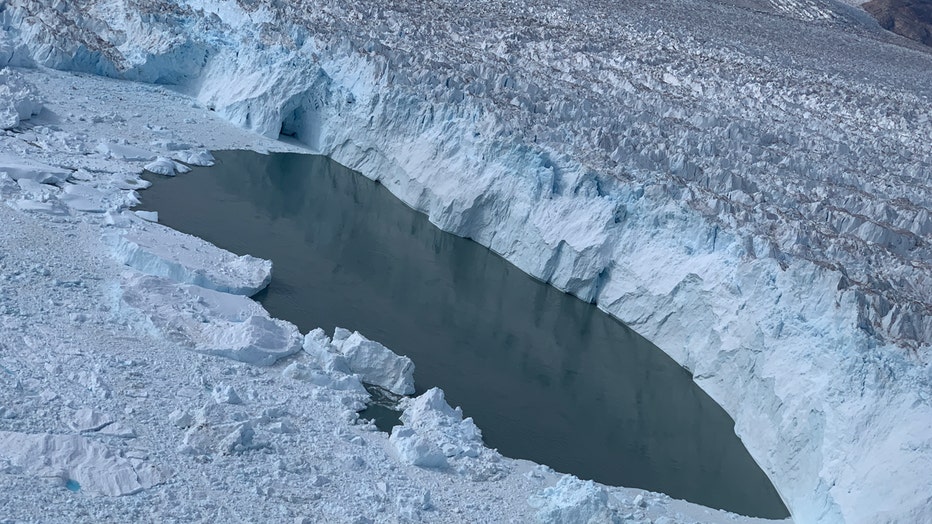Greenland lost 586 billion tons of ice in 2019 | Global Climate Crisis
from left, Helheim, Fenris and Midgard seen from the NASA/USGS Landsat 8 satellite, Aug. 12, 2019. (NASA image)
Greenland lost a record amount of ice during an extra warm 2019, with the melt massive enough to cover California in more than four feet (1.25 meters) of water, a new study said.
After two years when summer ice melt had been minimal, last summer shattered all records with 586 billion tons (532 billion metric tons) of ice melting, according to satellite measurements reported in a study Thursday. That's more than 140 trillion gallons (532 trillion liters) of water.
That's far more than the yearly average loss of 259 billion tons (235 billion metric tons) since 2003 and easily surpasses the old record of 511 billion tons (464 billion metric tons) in 2012, said a study in Nature Communications Earth & Environment. The study showed that in the 20th century, there were many years when Greenland gained ice.
"Not only is the Greenland ice sheet melting, but it's melting at a faster and faster pace," said study lead author Ingo Sasgen, a geoscientist at the Alfred Wegener Institute in Germany.
Last year's Greenland melt added 0.06 inches (1.5 millimeters) to global sea-level rise. That sounds like a tiny amount but "in our world it's huge, that's astounding," said study co-author Alex Gardner, a NASA ice scientist. Add in more water from melting in other ice sheets and glaciers, along with an ocean that expands as it warms — and that translates into slowly rising sea levels, coastal flooding and other problems, he said.

Glaciers in southeastern Greenland including, Glaciers in southeastern Greenland including, from left, Helheim, Fenris and Midgard seen from the NASA Landsat 1 satellite, September 1972. (NASA composite image)
While general ice melt records in Greenland go back to 1948, scientists since 2003 have had precise records on how much ice melts because NASA satellites measure the gravity of the ice sheets. That's the equivalent of putting the ice on a scale and weighing it as water flows off, Gardner said.
As massive as the melt was last year, the two years before were only on average about 108 billion tons (98 billion metric tons). That shows that there's a second factor called Greenland blocking, that either super-charges that or dampens climate-related melting, Gardner said.
In the summer, there are generally two factors in Greenland's weather, Gardner said. Last year, Greenland blocking — a high pressure over Canada that changes the northern jet stream — caused warm southern air to come up from the United States and Canada and flow into Greenland, forcing more melting.
In 2017 and 2018 without Greenland blocking, cooler Arctic air flowed from open ocean into Greenland, making summer milder, he said.

NASA’s Oceans Melting Greenland campaign flew over a region of open water at the calving front of Helheim Glacier on Aug. 15, 2019, dropping a temperature probe that detected warm water. (NASA image)
This year, Greenland's summer melt has been not as severe, closer to normal for recent times, said Ruth Mottram, an ice scientist at the Danish Meteorological Institute, who wasn't part of Sasgen's research.
Mottram and several other outside scientists said Sasgen's calculations make sense. In her own study this month in the International Journal of Climatology, she found similar results and also calculated that Greenland coastal regions have warmed on average 3 degrees (1.7 degrees Celsius) in the summer since 1991.
"The fact that 2019 set an all-time record is very concerning," said New York University ice scientist David Holland, who wasn't part of either study.
The Associated Press Health and Science Department receives support from the Howard Hughes Medical Institute's Department of Science Education. The AP is solely responsible for all content.
FROM THE FOX 5 NY ARCHIVES
MARCH 14, 2019: Protecting NYC from climate change
New York City Mayor Bill de Blasio is announcing a plan to protect lower Manhattan from rising sea levels by surrounding it with earthen berms and extending its shoreline by as much as 500 feet into the East River. That would be the equivalent of two city blocks.
Download the FREE Fox 5 NY weather app and always stay updated on storms. iOS from Apple App Store or Android from Google Play Store

